Palestinian vs Pakistani Disability Age Over 75
COMPARE
Palestinian
Pakistani
Disability Age Over 75
Disability Age Over 75 Comparison
Palestinians
Pakistanis
46.3%
DISABILITY AGE OVER 75
97.7/ 100
METRIC RATING
99th/ 347
METRIC RANK
47.7%
DISABILITY AGE OVER 75
23.4/ 100
METRIC RATING
197th/ 347
METRIC RANK
Palestinian vs Pakistani Disability Age Over 75 Correlation Chart
The statistical analysis conducted on geographies consisting of 216,314,084 people shows a moderate positive correlation between the proportion of Palestinians and percentage of population with a disability over the age of 75 in the United States with a correlation coefficient (R) of 0.422 and weighted average of 46.3%. Similarly, the statistical analysis conducted on geographies consisting of 334,776,547 people shows no correlation between the proportion of Pakistanis and percentage of population with a disability over the age of 75 in the United States with a correlation coefficient (R) of 0.036 and weighted average of 47.7%, a difference of 2.8%.

Disability Age Over 75 Correlation Summary
| Measurement | Palestinian | Pakistani |
| Minimum | 31.0% | 14.0% |
| Maximum | 100.0% | 91.0% |
| Range | 69.0% | 77.0% |
| Mean | 47.0% | 50.7% |
| Median | 45.4% | 48.4% |
| Interquartile 25% (IQ1) | 41.2% | 44.6% |
| Interquartile 75% (IQ3) | 48.8% | 56.3% |
| Interquartile Range (IQR) | 7.5% | 11.7% |
| Standard Deviation (Sample) | 12.6% | 14.7% |
| Standard Deviation (Population) | 12.5% | 14.6% |
Similar Demographics by Disability Age Over 75
Demographics Similar to Palestinians by Disability Age Over 75
In terms of disability age over 75, the demographic groups most similar to Palestinians are Immigrants from Eastern Europe (46.3%, a difference of 0.0%), Mongolian (46.3%, a difference of 0.0%), Immigrants from Japan (46.3%, a difference of 0.040%), Finnish (46.3%, a difference of 0.050%), and Immigrants from China (46.3%, a difference of 0.070%).
| Demographics | Rating | Rank | Disability Age Over 75 |
| Germans | 98.2 /100 | #92 | Exceptional 46.3% |
| Ugandans | 98.2 /100 | #93 | Exceptional 46.3% |
| Albanians | 98.1 /100 | #94 | Exceptional 46.3% |
| Immigrants | Brazil | 98.0 /100 | #95 | Exceptional 46.3% |
| Immigrants | China | 98.0 /100 | #96 | Exceptional 46.3% |
| Finns | 97.9 /100 | #97 | Exceptional 46.3% |
| Immigrants | Japan | 97.8 /100 | #98 | Exceptional 46.3% |
| Palestinians | 97.7 /100 | #99 | Exceptional 46.3% |
| Immigrants | Eastern Europe | 97.7 /100 | #100 | Exceptional 46.3% |
| Mongolians | 97.7 /100 | #101 | Exceptional 46.3% |
| Immigrants | Malaysia | 97.1 /100 | #102 | Exceptional 46.4% |
| Ukrainians | 97.1 /100 | #103 | Exceptional 46.4% |
| Israelis | 97.0 /100 | #104 | Exceptional 46.4% |
| Immigrants | Cameroon | 96.9 /100 | #105 | Exceptional 46.4% |
| Immigrants | Kuwait | 96.8 /100 | #106 | Exceptional 46.4% |
Demographics Similar to Pakistanis by Disability Age Over 75
In terms of disability age over 75, the demographic groups most similar to Pakistanis are Immigrants from Portugal (47.6%, a difference of 0.010%), Immigrants from Ukraine (47.7%, a difference of 0.010%), Immigrants from Eritrea (47.7%, a difference of 0.030%), Immigrants from Trinidad and Tobago (47.6%, a difference of 0.060%), and Immigrants from Somalia (47.7%, a difference of 0.070%).
| Demographics | Rating | Rank | Disability Age Over 75 |
| Somalis | 29.5 /100 | #190 | Fair 47.6% |
| Portuguese | 29.3 /100 | #191 | Fair 47.6% |
| Immigrants | Jamaica | 28.3 /100 | #192 | Fair 47.6% |
| Ottawa | 28.1 /100 | #193 | Fair 47.6% |
| Immigrants | Lebanon | 26.5 /100 | #194 | Fair 47.6% |
| Immigrants | Trinidad and Tobago | 25.3 /100 | #195 | Fair 47.6% |
| Immigrants | Portugal | 23.8 /100 | #196 | Fair 47.6% |
| Pakistanis | 23.4 /100 | #197 | Fair 47.7% |
| Immigrants | Ukraine | 23.2 /100 | #198 | Fair 47.7% |
| Immigrants | Eritrea | 22.4 /100 | #199 | Fair 47.7% |
| Immigrants | Somalia | 21.4 /100 | #200 | Fair 47.7% |
| Immigrants | Cuba | 20.9 /100 | #201 | Fair 47.7% |
| Immigrants | Bahamas | 20.7 /100 | #202 | Fair 47.7% |
| Trinidadians and Tobagonians | 20.0 /100 | #203 | Fair 47.7% |
| Nigerians | 19.2 /100 | #204 | Poor 47.7% |